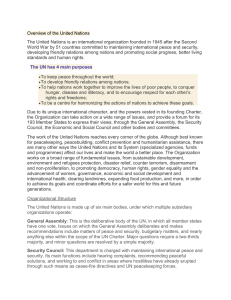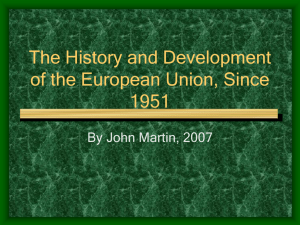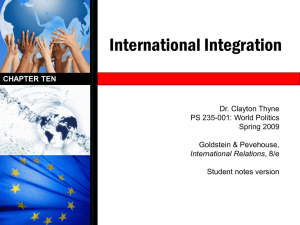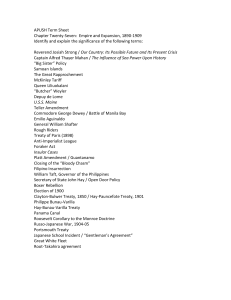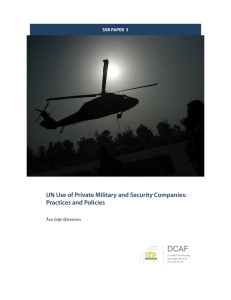Chapter 25 Section 3 - Guthrie Public Schools
advertisement
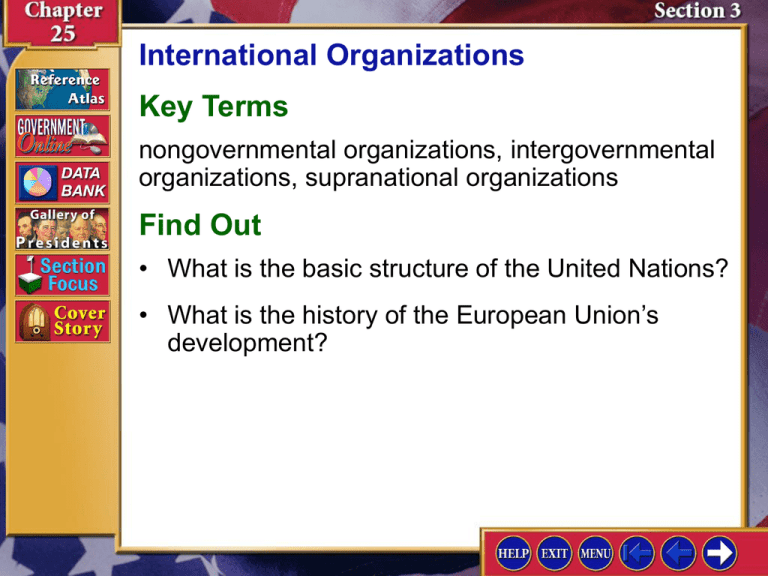
International Organizations Key Terms nongovernmental organizations, intergovernmental organizations, supranational organizations Find Out • What is the basic structure of the United Nations? • What is the history of the European Union’s development? International Organizations Understanding Concepts Political Processes How does the UN Security Council operate and guide the decisions of the General Assembly? Section Objective Evaluate the impact of international organizations on global affairs. The idea of the European Union was conceived to prevent the killing and destruction of World War II from ever happening again. The idea was first proposed by French foreign minister Robert Schuman in a speech on May 9, 1950. This date, the “birthday” of what is now the EU, is celebrated annually as Europe Day. I. The United Nations (pages 702–704) A. The United Nations (UN) provides a forum for nations to settle disputes peacefully through cooperation rather than conflict. B. The General Assembly is made up of delegations of five representatives from each member nation. C. The UN Security Council is composed of 15 nations, 5 of which are permanent members. It has the authority to make peacekeeping decisions for the UN. D. The Secretariat conducts the UN’s day-today business and is headed by the Secretary General, who carries out the instructions of the Security Council. I. The United Nations (pages 702–704) E. The International Court of Justice settles disputes involving international law. F. The Economic and Social Council promotes social and economic progress around the world. G. The UN also has special agencies that carry out humanitarian activities. H. UN peacekeeping often involves inserting an international force of troops between combatants to calm volatile situations; sometimes lightly armed peacekeeping forces will oversee elections or provide humanitarian aid. I. The United Nations (pages 702–704) I. The United Nations (pages 702–704) Some Americans object to a nation’s having to surrender any portion of its sovereignty to the United Nations. What is your opinion? Answers will vary. This has been a sensitive issue in American politics since 1945. II. The European Union (pages 704–706) A. The European Union (EU) is a political and economic partnership among 15 European nations. B. The EU began in 1957 as a trading market among six Western European nations; as more countries joined, the Maastricht Treaty enabled the EU to gain power and begin acting as a political unit. C. Major EU policy is decided by the Council of the European Union. II. The European Union (pages 704–706) D. The European Parliament contains 732 members and is the legislative branch of the EU. E. The European Court of Justice hears cases and can declare laws of member nations invalid if they conflict with EU treaty obligations. F. The European Commission does the daily work in the EU; the President of the Commission directs the large EU bureaucracy and oversees the annual budget. II. The European Union (pages 704–706) Many Europeans complain that the EU bureaucracy is too large and is not responsive to the needs of the public. What is your opinion? Answers will vary. Students should demonstrate knowledge of the structure of EU government. Checking for Understanding 1. Main Idea Use a graphic organizer like the one below to summarize the two international organizations described in this section. UN—191 member nations; wants to preserve world peace, encourage nations to act fairly, and help nations to cooperate in solving problems. EU—25 member nations; formed to allow European nations to band together to cooperate politically and economically. Checking for Understanding 2. Define nongovernmental organizations, intergovernmental organizations, supranational organizations. Nongovernmental organizations are international organizations comprised of individuals and groups outside the scope of government. Intergovernmental organizations are organizations comprised of members of national governments. Supranational organizations are organizations whose authority overrides the sovereignty of its individual members. Checking for Understanding 3. Identify General Assembly, Security Council, Secretariat, Maastricht Treaty, European Parliament. The General Assembly is the central council that discusses, debates, and recommends solutions presented to the United Nations. The Security Council is the executive board of the UN and has the authority to make peacekeeping decisions. The Secretariat is responsible for the UN’s day-to-day business operations. The Maastricht Treaty is a treaty that has allowed for greater integration of political and economic power in the EU. The European Parliament is the legislative branch of the EU. Checking for Understanding 4. List some incidences where the UN has acted as a peacekeeper in a nonmilitary setting. Examples may include overseeing elections or providing humanitarian aid. Checking for Understanding 5. How has European Union expansion affected the European Commission? It has changed the makeup of the European Commission as far as how many members represent each participating nation. Critical Thinking 6. Analyzing Information Should the five permanent members of the UN Security Council be able to override any UN decision? Why or why not? Students’ responses will vary but should be supported by evidence from the text. Political Processes Identify and find out about the duties, responsibilities, and programs of the specialized agencies of the United Nations. Create a poster that illustrates the work of these agencies. Display completed posters in the classroom.
